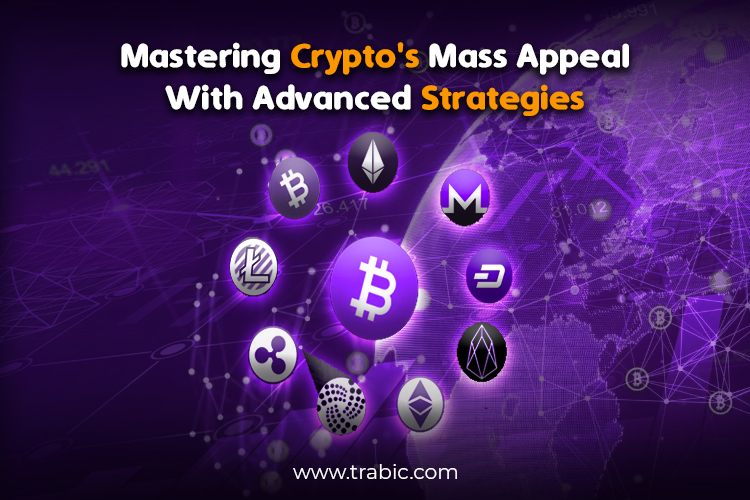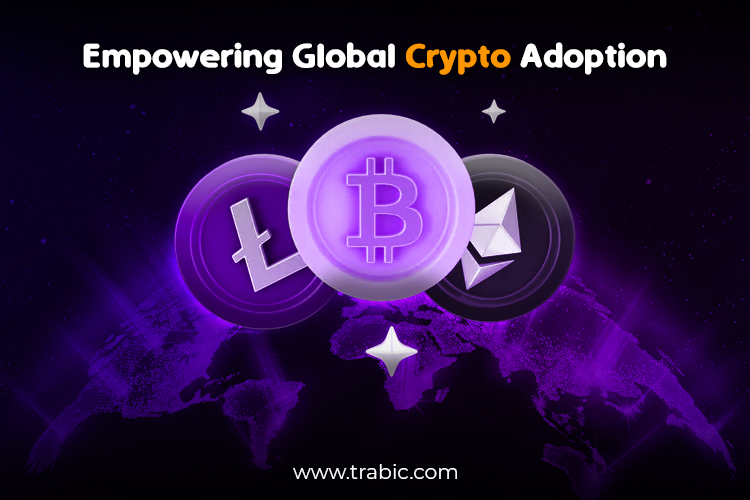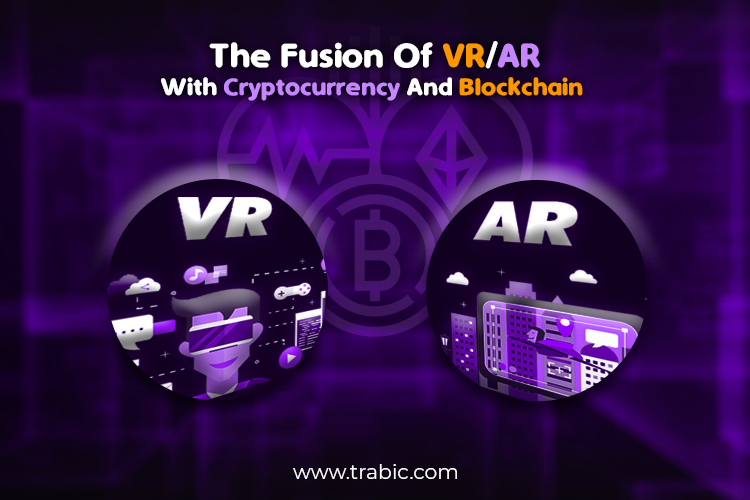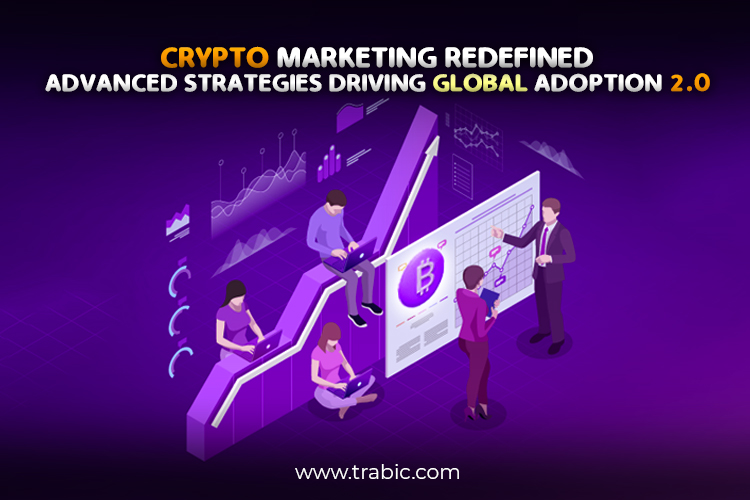Cryptocurrencies have come a long way since the inception of Bitcoin over a decade ago. From being seen as a niche and speculative investment, the crypto market has matured into a diverse ecosystem with the potential to revolutionize various industries. However, mass adoption is essential for cryptocurrencies to reach their full potential. To achieve this, crypto marketing must evolve beyond the traditional methods used in the past. In this blog, we will explore Crypto Marketing 2.0, which focuses on harnessing advanced strategies to drive the widespread adoption of cryptocurrencies.
Before diving into the advanced strategies, let’s first understand the challenges that the crypto industry faces regarding mass adoption:
Lack of Awareness: Despite growing popularity, many individuals need to know cryptocurrencies’ benefits.
The need for more awareness is one of the key challenges hindering the mass adoption of cryptocurrencies. Several reasons are contributing to this phenomenon:
- Novelty and Complexity: Cryptocurrencies and blockchain technology are relatively new concepts that emerged over the past decade. For many people, these technologies can be challenging to understand due to their complex technical nature, making it difficult for the average person to grasp the intricacies of how they work.
- Limited Media Coverage: While cryptocurrencies have gained more attention over the years, mainstream media coverage still needs to be improved compared to traditional financial markets. This lack of comprehensive reporting on cryptocurrencies can make the general public unaware of their potential and benefits.
- Negative Media Perception: Cryptocurrencies have been associated with high-profile scams, hacks, and illegal activities, which can lead to negative perceptions and fear among the public. Such incidents can overshadow cryptocurrencies’ legitimate and positive use cases, contributing to the need for more awareness.
- Educational Gap: There needs to be more formal education on cryptocurrencies and blockchain technology in traditional educational systems. As a result, individuals may need access to reliable sources to learn about cryptocurrencies, leading to a general need for more awareness.
- Limited Industry Advertising: While some crypto companies and projects invest in marketing and advertising, the overall spending on crypto advertising is considerably lower than in traditional industries. This lack of marketing efforts in mainstream channels can limit the reach and exposure of cryptocurrencies to the broader public.
- Skepticism and Misinformation: Due to the decentralized and relatively unregulated nature of the crypto market, there is often misinformation and skepticism surrounding cryptocurrencies. This misinformation can lead to misunderstandings and mistrust, further contributing to the need for more awareness.
- Regulatory Uncertainty: Varying regulatory environments in different countries can create confusion and uncertainty about the legality and legitimacy of cryptocurrencies. This uncertainty can deter individuals and businesses from exploring cryptocurrencies, leading to a lack of awareness.
- Risk Perception: Many people perceive cryptocurrencies as high-risk and volatile investments due to the market’s history of price fluctuations. This perception can discourage potential users from exploring cryptocurrencies for transactions or investments.
The crypto comments for more industry players must prioritize educational efforts to address the need for more awareness. This includes creating user-friendly educational resources, conducting workshops, and engaging with mainstream media to provide accurate and unbiased information about cryptocurrencies and their potential benefits. Additionally, fostering transparent and secure use cases of cryptocurrencies can help build trust and credibility, ultimately driving greater awareness and adoption.
- Complexity: Crypto-related terminologies and technological aspects can overwhelm newcomers, hindering their entry into the market.
- Security Concerns: High-profile hacks and scams have created a perception of insecurity surrounding cryptocurrencies.
- Regulatory Uncertainty: Varying regulations in different countries can cause confusion and hinder the widespread acceptance of cryptocurrencies.
Advanced Strategies for Mass Crypto Adoption:

- Educational Campaigns: To address the need for more awareness and understanding, crypto marketing should prioritize educational campaigns. This includes creating user-friendly content, explainer videos, and interactive tutorials to demystify crypto concepts for the general public. Collaborating with influencers and hosting webinars can also boost the effectiveness of educational efforts.
- Gamification and Rewards: Gamifying the crypto experience can be a powerful way to engage users. Implementing reward systems, such as airdrops and loyalty programs, incentivizes adoption and fosters a sense of community around a particular cryptocurrency or platform.
- User-Centric Design: Simplifying the user experience is crucial for broader adoption. Crypto Marketing platforms and wallets should prioritize intuitive user interfaces, ensuring that even those with minimal technical knowledge can navigate and use them effortlessly.
- Security Measures: Addressing security concerns is paramount. Marketing campaigns should emphasize the robust security measures implemented by cryptocurrencies and platforms to safeguard user funds and data.
- Regulatory Compliance: Working with regulators and policymakers to establish clear guidelines and standards can help build trust and legitimacy in the crypto market. To reassure potential users, marketing efforts should highlight compliance with relevant laws and regulations.
- Integration with Everyday Life: Cryptocurrencies must integrate seamlessly into everyday life to facilitate mass adoption. Marketing should emphasize real-world use cases, such as e-commerce, remittances, and peer-to-peer transactions, to illustrate the practicality and convenience of using cryptocurrencies.
- Leveraging Social Media: Social media platforms are crucial in shaping public opinion. Targeted advertising, engaging content, and interactive campaigns on platforms like Twitter, Facebook, and TikTok can attract a wider audience.
- Partnerships and Alliances: Collaborating with established brands and companies can significantly enhance the credibility of cryptocurrencies. Joint marketing efforts can introduce cryptocurrencies to new user bases and open up more avenues for adoption.
- Community Building: Building and nurturing a vibrant and engaged community around a cryptocurrency or blockchain project can foster word-of-mouth marketing and create a supportive ecosystem that encourages newcomers to join.
Here are more points to further explore the advanced strategies for mass crypto adoption:

- Decentralized Finance (DeFi) Awareness: DeFi has emerged as one of the most significant cryptocurrency use cases. Crypto Marketing efforts should highlight the benefits of decentralized lending, staking, yield farming, and other DeFi applications, showcasing how they can empower individuals by offering financial services without intermediaries.
- NFTs and Creative Expression: Non-Fungible Tokens (NFTs) have revolutionized the art and entertainment industries by enabling digital artists, musicians, and creators to monetize their work directly. Crypto marketing should emphasize NFTs’ potential to reshape how creative content is bought and sold, bridging the distance between artists and their audience.
- Environmental Sustainability: The energy consumption associated with some blockchain networks has raised concerns about the environmental impact of cryptocurrencies. Marketing campaigns should highlight eco-friendly alternatives and emphasize the steps taken by projects to minimize their carbon footprint.
- Financial Inclusion: Crypto marketing should focus on how cryptocurrencies can bring financial services to the unbanked and underbanked populations, particularly in regions with limited access to traditional banking infrastructure.
- Microtransactions and Micropayments: Microtransactions made possible by cryptocurrencies can enable frictionless and cost-effective payments for small services, content, or products. This use case can be highlighted to demonstrate the potential of cryptocurrencies in the digital economy.
- Institutional Adoption: Collaborating with institutional investors and corporations can bring credibility and legitimacy to the crypto market. Marketing efforts should target institutions, showcasing the advantages of diversifying their portfolios with cryptocurrencies.
- Cross-Border Remittances: Cryptocurrencies can significantly reduce the costs and time associated with cross-border remittances. Marketing should emphasize the speed and cost-effectiveness of sending funds globally using cryptocurrencies.
- Education for Retailers: Besides educating the public, crypto marketing should also educate merchants and retailers about accepting cryptocurrencies as payment. Providing them with the necessary tools and support to integrate crypto payments can drive adoption.
- Regulatory Advocacy: Crypto marketing should encourage users to advocate for favorable and balanced crypto regulations. Demonstrating the positive impact of straightforward and supportive regulations can create a conducive environment for crypto adoption.
- Use of Virtual and Augmented Reality: Immersive technologies like virtual and augmented reality can be leveraged in crypto marketing to create engaging experiences, such as virtual crypto conferences, product showcases, and educational simulations.
Immersive Innovations: Merging Virtual Reality and Augmented Reality with Cryptocurrencies
- VR and AR in Gaming: One of the most prominent applications of VR and AR is in the gaming industry. Cryptocurrencies can create unique in-game assets and items represented as NFTs. Players can purchase, sell, and trade these assets on blockchain-powered marketplaces, giving them actual ownership and value. This enhances the gaming experience, allowing players to earn value for their time and effort spent in virtual worlds.
- Virtual Real Estate and Social Spaces: VR and AR can create immersive virtual worlds where users can interact, socialize, and even own virtual real estate. Blockchain technology can facilitate the creation and trade of virtual properties as NFTs, enabling users to invest in virtual spaces and monetize their digital assets.
- AR for Retail and Advertising: Augmented Reality can enhance the retail experience by overlaying digital information on physical products or spaces. Cryptocurrencies can be integrated to enable seamless payments in AR shopping experiences. AR-based advertising campaigns can leverage blockchain to ensure transparency and accountability in ad impressions and user engagement.
- Virtual Events and Conferences: VR can be used to host virtual events, conferences, and meetups, bringing people together from around the world without the need for physical travel. Cryptocurrencies can facilitate ticketing, registration, and even virtual merchandise purchases for these events, offering secure and borderless transactions.
- Virtual Art Galleries and Museums: NFTs have disrupted the art industry, enabling artists to tokenize and sell their digital creations as unique collectibles. VR can enhance this experience by creating virtual art galleries and museums where users can view and interact with NFT-based artworks, fostering a new era of digital art appreciation.
- VR Education and Training: Virtual classrooms and training simulations can benefit from cryptocurrencies by enabling secure and transparent payment systems for courses and educational content. Smart contracts can also automate certificate verification, issuance, and credentials.
- Remote Collaboration and Workspaces: VR can create collaborative virtual workspaces, enabling teams to work together seamlessly, irrespective of their physical locations. Cryptocurrencies can facilitate the payment of freelancers and remote workers borderless and efficiently.
- Virtual Tourism and Exploration: AR can enrich the tourism experience by providing digital overlays of information and historical context on physical landmarks and tourist sites. Cryptocurrencies can be used for ticketing and payments in virtual tourist destinations.
It’s important to note that while integrating VR and AR with cryptocurrencies presents numerous opportunities, challenges such as scalability, user adoption, and technical hurdles exist. However, as these technologies continue to advance and mature, their combination has the potential to reshape industries and create new and exciting experiences for users worldwide.

Global Community Events: Organizing global crypto-themed events, conferences, and hackathons can bring together enthusiasts, developers, and experts, fostering networking opportunities and knowledge-sharing and promoting mass adoption.
As cryptocurrencies continue to gain popularity and mature, their impact extends beyond the financial sector into various other fields. While I cannot provide real-time predictions as my knowledge is up to September 2021, I can highlight some potential areas where cryptocurrencies are likely to make significant contributions:
- Supply Chain and Logistics: Cryptocurrencies can streamline supply chain management by enabling transparent and secure tracking of goods. Blockchain technology, which underpins many Crypto Marketing, can create immutable records of product origin, transportation, and handling, reducing fraud and ensuring product authenticity.
- Healthcare: In the healthcare sector, cryptocurrencies can improve medical records management, ensuring patient data security and interoperability across different healthcare providers. Additionally, tokenizing healthcare assets and intellectual property could enable efficient fundraising for research and development.
- Intellectual Property and Copyright: NFTs (Non-Fungible Tokens) based on blockchain technology have already disrupted the art and entertainment industries. These unique tokens can also be applied to establish intellectual property ownership and authenticity, providing artists, writers, and creators with a secure and transparent way to monetize their work.
- Voting Systems: Blockchain-based cryptocurrencies have the potential to revolutionize voting systems, ensuring tamper-proof and transparent elections. By providing secure and verifiable voting records, cryptocurrencies could enhance voter confidence and strengthen democratic processes.
- Real Estate: Tokenizing real estate assets can unlock liquidity and enable fractional ownership of properties. Investors can buy and sell property tokens, making real estate investment more accessible and flexible.
- Gaming and Virtual Economies: Cryptocurrencies have made significant inroads into the gaming industry, enabling players to earn and trade in-game assets using Crypto Marketing blockchain technology. This concept of virtual economies can be expanded to other virtual worlds and online platforms.
- Renewable Energy and Sustainability: Cryptocurrencies can incentivize renewable energy production by creating marketplaces for buying and selling excess energy. Blockchain-based systems can facilitate peer-to-peer energy trading, promoting sustainable practices.
- Identity Management: Blockchain-based cryptocurrencies can create self-sovereign identity systems where individuals have complete control over their data. This can simplify identity verification processes and enhance data privacy.
- Charity and Philanthropy: Cryptocurrencies can facilitate more transparent and efficient donation systems, enabling donors to track how their contributions are used in real-time. Additionally, blockchain-based smart contracts can automate charitable fund distributions.
- Internet of Things (IoT): Integrating cryptocurrencies with IoT devices can enable seamless and automated micro-transactions between machines, promoting a more interconnected and autonomous ecosystem.
It’s important to note that the success of cryptocurrencies in these fields will depend on various factors, including regulatory developments, technological advancements, and user adoption. As the crypto industry continues to evolve, its impact on these and other fields may become more pronounced, shaping how we interact and conduct business in the future.
Crypto Marketing 2.0 Scope:
Crypto Marketing 2.0 involves a multi-faceted approach that combines educational campaigns, gamification, user-centric design, security measures, and real-world integration. By showcasing cryptocurrencies’ practicality, efficiency, and potential positive impact, the industry can overcome barriers to mass adoption and drive mainstream acceptance. With innovative strategies and a focus on building trust and legitimacy, the crypto market can continue its path toward revolutionizing the financial landscape and reshaping various industries.
Crypto Marketing 2.0 represents a significant step forward in the drive toward mass adoption of cryptocurrencies. The industry can overcome the challenges and misconceptions that hinder broader acceptance by focusing on educational initiatives, user-centric design, security, and real-world integration. As the crypto market continues to evolve, innovative marketing strategies will be the catalysts that propel cryptocurrencies into the mainstream, paving the way for a decentralized and inclusive financial future.
In conclusion, the discussion on “Crypto Marketing 2.0: Harnessing Advanced Strategies for Mass Crypto Adoption” and “The Use of Virtual and Augmented Reality in Conjunction with Cryptocurrencies” highlights the transformative potential of cryptocurrencies and their integration with cutting-edge technologies.
Cryptocurrencies have evolved significantly from their early days and are no longer limited to being speculative assets. They have become part of a diverse ecosystem with the capacity to revolutionize various industries. However, mass adoption is crucial for cryptocurrencies to reach their full potential.
To achieve mass adoption, crypto marketing must evolve beyond traditional methods. “Crypto Marketing 2.0” emphasizes advanced strategies like educational campaigns, gamification, user-centric design, security measures, and real-world integration. These approaches address challenges such as lack of awareness, complexity, and security concerns, fostering trust and legitimacy in the crypto market.
Furthermore, integrating Virtual Reality (VR) and Augmented Reality (AR) with cryptocurrencies opens up new possibilities. The gaming industry benefits from blockchain-backed in-game assets and actual ownership through NFTs, while virtual real estate and social spaces empower users to invest in and monetize virtual properties.
Beyond gaming, VR and AR find applications in retail, advertising, events, education, art, tourism, and remote collaboration, enhancing user experiences and creating innovative business models. Users can enjoy greater security, transparency, and control over their digital assets and interactions by leveraging cryptocurrencies and blockchain technology in these immersive environments.
Challenges in pursuing mass crypto adoption and VR/AR integration exist, including regulatory uncertainty, technical hurdles, and the need for widespread user education. However, the continuous advancements in cryptocurrency and immersive technologies suggest a promising future for their widespread acceptance and integration into everyday life.
As the crypto and VR/AR industries evolve, innovative strategies and collaborative efforts will drive mainstream adoption, reshaping industries and unlocking new opportunities for global connectivity and financial empowerment. The convergence of these technologies holds immense potential to shape a more inclusive, decentralized, and interconnected future.
